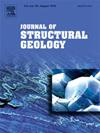剪切带褶皱:构造分析与解释
IF 2.9
2区 地球科学
Q2 GEOSCIENCES, MULTIDISCIPLINARY
引用次数: 0
摘要
剪切带及其伴生褶皱是造山带内部广泛发育的一类重要构造。对这些褶皱的分析是至关重要的,因为它们可以用来帮助确定地壳尺度剪切带的运动学、体应变和变形历史,以及影响流体流动和潜在的矿化。我们的案例研究集中在爱尔兰西北部的加里东剪切带,该剪切带的标志是北西向的地壳增厚(D1),随后是北西向的重力驱动的伸展塌陷(D2)。我们对绿片岩相伸展期间形成的介观褶皱和组构进行了详细的分析,以回答一些一般性的问题,包括如何区分褶皱的铰链是平行于运输的,还是向剪切方向旋转的,大褶皱对小褶皱的几何形状和方向的控制,以及岩性对剪切带褶皱演化的影响。我们的研究包括一个混合褶皱和织物数据集,这些数据集来自于以下几个复杂的组合:i)流动扰动褶皱与铰链,它们已经开始了亚平行的运输;ii)鞘状褶皱与铰链,它们在强烈的渐进剪切过程中已经向运输方向旋转;iii)螺旋褶皱与铰链,它们开始了正常的运输,但在滚动和收紧时没有旋转。这些介观褶皱在一系列尺度上形成,较小的褶皱以各种角度形成,在某些情况下横切较大的褶皱铰链,表明非pumpellyan或不协调的关系。与较弱的泥岩相比,称职的沙石拥有更多开放的褶皱,铰链在更高的角度上进行运输,而较弱的泥岩则包含更紧密的褶皱,在可变角度上进行剪切。因此,岩性和规模是控制剪切带褶皱的关键因素,自然数据集通常以较小规模(<;10厘米)的褶皱为主,这些褶皱更普遍,在露头处更容易测量。记录数据中这种偏差的一个后果是折叠旋转量(以及因此产生的整体应变)可能被高估。更复杂的是,与更接近底层分离的更紧的下铰链相比,折叠对保留了更多开放的上铰链,这意味着折叠对中铰链的确切位置应该定期记录。称职沙质岩内褶皱褶皱褶皱褶皱的变平反映了重力驱动形变对东南方向剪切的绝对自上而下的影响,我们认为这是造山崩塌过程中剪切带的集中。本文章由计算机程序翻译,如有差异,请以英文原文为准。

Shear zone folds: Structural analysis and interpretation
Shear zones and associated folds form an important category of structures that are widely developed in the internal portions of orogenic belts. The analysis of such folds is crucial as they can be used to help determine kinematics, bulk strain and deformation histories of crustal-scale shear zones as well as influencing fluid flow and potential mineralisation. Our case study focuses on a Caledonian shear zone in NW Ireland that is marked by NW-directed crustal thickening (D1) that is followed by a later phase (D2) of SE-directed gravity-driven extensional collapse. We provide a detailed analysis of mesoscopic folds and fabrics formed during this greenschist-facies extension in order to answer some general questions including how to distinguish folds with hinges that initiate parallel to transport versus those folds that have rotated towards shear, the control that larger folds may have upon the geometry and orientation of smaller folds, and the influence that lithology plays in the evolution of shear zone folds. Our study comprises a mixed fold and fabric data set derived from a complex combination of i) flow perturbation folds with hinges that have initiated sub-parallel to transport, ii) sheath folds with hinges that have rotated towards transport during intense progressive shear, and iii) spiral folds with hinges that initiate normal to transport but fail to rotate as they roll and tighten. These mesoscopic folds form across a range of scales with smaller folds forming at a variety of angles, and in some cases transecting larger fold hinges indicating a non-Pumpellyan or incongruous relationship. Competent psammites host more open folds with hinges at higher angles to transport when compared to weaker pelites that contain tighter folds at variable angles to shear. Lithology and scale are therefore critical factors in controlling shear zone folds, with natural data sets commonly dominated by smaller-scale (<10 cm) folds that are more prevalent and easier to measure at outcrop. A consequence of this bias in recording data is that the amount of fold rotation (and hence bulk strain) may be over-estimated. A further complication is that fold pairs preserve more open upper hinges compared to tighter lower hinges that are closer to underlying detachments, meaning that the exact position of the hinge within fold pairs should be routinely recorded. The flattening of buckle fold hinges within competent psammites reflects the influence of gravity-driven deformation with an absolute sense of top-down-to the SE shear, which we interpret as being focussed into the shear zone during orogenic collapse.
求助全文
通过发布文献求助,成功后即可免费获取论文全文。
去求助
来源期刊

Journal of Structural Geology
地学-地球科学综合
CiteScore
6.00
自引率
19.40%
发文量
192
审稿时长
15.7 weeks
期刊介绍:
The Journal of Structural Geology publishes process-oriented investigations about structural geology using appropriate combinations of analog and digital field data, seismic reflection data, satellite-derived data, geometric analysis, kinematic analysis, laboratory experiments, computer visualizations, and analogue or numerical modelling on all scales. Contributions are encouraged to draw perspectives from rheology, rock mechanics, geophysics,metamorphism, sedimentology, petroleum geology, economic geology, geodynamics, planetary geology, tectonics and neotectonics to provide a more powerful understanding of deformation processes and systems. Given the visual nature of the discipline, supplementary materials that portray the data and analysis in 3-D or quasi 3-D manners, including the use of videos, and/or graphical abstracts can significantly strengthen the impact of contributions.
 求助内容:
求助内容: 应助结果提醒方式:
应助结果提醒方式:


